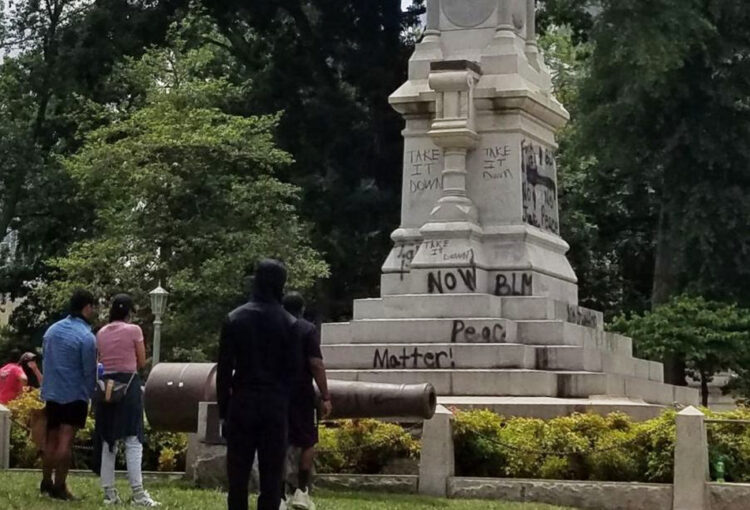
The North Carolina Confederate Monument was dismantled at the State Capitol in June 2020 | Photo: Clayton Henkel
April 19. [Analysis] By Kelan Lyons/NC Newsline. Jeremy Collins didn’t know where he was going to get one, but he needed a crane. It was June 2020, a month after George Floyd’s murder. Collins’s boss, Gov. Roy Cooper, had just ordered the removal of three Confederate monuments in Raleigh after protestors had toppled two bronze Confederate soldier statues at the State Capitol.
The problem was, they didn’t have anyone to complete the job. State Department of Transportation workers had dismantled a piece of a monument but then walked off the site, too intimidated to continue.
“They said they had received death threats and they didn’t care who the governor was, they were not going to risk their lives to take down this monument,” Collins said at a panel about Confederate statues last week. “They had taken the man off the top of the monument and they felt like that was good enough. And if the governor wanted to do more, he’d have to do it himself.”
Cooper wouldn’t do it himself. He had said the monuments had to come down because keeping them up was a public safety risk, but Collins said the governor didn’t come to the grounds to make sure it happened or otherwise commit to seeing them toppled.
No easy solution
After the DOT employees’ walk-off and the governor’s lack of follow-through, Collins had a realization: “We’re going to have to find an entire chain of people that are uncompromised by white supremacy,” Collins said. “We’re going to have to find a Black contractor, we’re going to have to find a Black crane operator. There can be no person who is afraid of anti-racism to do this.”
But Collins couldn’t find a Black person or a Black-owned construction company that had a crane. He called Calvin Stevens, the president of CATE Services & Construction, who found a man in South Carolina willing to risk the threats to lend his crane. But, Stevens said, South Carolina wouldn’t let them use their highways to transport it to Raleigh.
Eventually Stevens found a white man in Sampson County who’d told them he ordinarily wouldn’t contribute to the cause, but he was in poor health and wanted to atone for the way he’d lived. Then the state of North Carolina told Collins a permit was required. That would take at least a couple days, assuming it was even approved.
They shut down the highways
Collins called Col. Glen McNeil, a Black man with the North Carolina Highway Patrol, who arranged a police escort from Sampson County to Raleigh. The permit-less crane was transported the roughly 70 miles without stopping, to ensure it, and everyone involved, arrived safely.
“Basically they shut down the highways,” Collins said. “There was a certain dualities of existence because we are tearing down this white supremacy monument and we’ve got the upholders of white supremacy escorting us into the town.”
Collins and Stevens recounted the harrowing ordeal in a panel hosted last week by the North Carolina Commission on Racial and Ethnic Disparities in the Criminal Justice System, known as NC CRED. Each of the panelists had played a role in removing Confederate monuments from their towns or at the Capitol — and experienced the backlash that comes with it.
Hate mail, death threats
“You make angry white people even angrier,” said W. Mondale Robinson, a panelist and the mayor of Enfield responsible for toppling a Confederate monument in a public park in the Halifax County town.
Robinson, who is Black, said he now receives hate mail at his office and house. His parents’ address has been posted online. He regularly gets death threats.
Constituents called James Crawford, a white man and former Chatham County commissioner, a “traitor” when he and his colleagues considered removing a Confederate monument in 2019.
“We had to be escorted by the police, the deputies, to our cars after every meeting, whether or not the statute was on the agenda for the better part of the year,” Crawford said.

Confederate monument in Cornelius
Under cover of darkness, crews later took that monument down overnight.
[In Cornelius, church leaders have asked for a Confederate monument in front of Mt. Zion United Methodist to be taken down.]
Again and again, the conversation returned to the role Stevens and Collins played in the toppling of Confederate monuments in downtown Raleigh in 2020. Dawn Blagrove, executive director of Emancipate NC and moderator of the panel, called the phone call chain between Stevens, Collins, and McNeil an “Underground Railroad.”
Each of the panelists reviewed the obstacles they faced in removing Confederate monuments: the permits, threats, rage, powerful white people merely masquerading as allies, the character assassination in the press.
Legal issues
Earlier in the day another panelist mentioned a 2015 law requiring approval from the North Carolina Historical Commission before Confederate monuments could be relocated or removed. That statute also prohibits the permanent removal of such figures, but critics have said the wording potentially leaves an opening for at least temporary removal or relocation.
Deborah Gerhardt, a law professor at UNC-Chapel Hill and a member of the earlier panel, said the supremacy clause of the U.S. Constitution supersedes North Carolina’s law. She also published a paper last year arguing that the Federal Civil Rights Act could be used to remove monuments that make a workplace or educational setting more hostile.
“We can’t give up because of the state statute,” Gerhardt said.
In the later panel, Blagrove said that adhering to the law and “following the appropriate channels” isn’t what brings Confederate monuments down.
“What gets the statue removed is someone who is willing to take revolutionary action,” Blagrove said. “There is no ‘right’ way to tear down oppressive systems.”
That’s a lesson Collins said he learned after Cooper failed to take on a prominent role in toppling the monuments.
Keeping order and the weight of it all
“People who you think are allies with you become agitators against you, because they’re more concerned with keeping order than they are with doing justice,” Collins said.

Gov. Cooper
Sadie Weiner, Director of External Affairs for the Governor’s office, disputed the notion that Cooper failed to take strong action, saying “Governor Cooper ordered the removal of monuments from the Capitol grounds and he and dozens of people in his administration worked diligently around the clock until the job was done.”
When the time came to remove the Confederate monuments from their place of prominence, it was Stevens and Collins and their phone-line “Underground Railroad” who were there. Even after all the prep work, Stevens said something about the 50,000-pound monument surprised him.
“They’re not being held in place by anything,” he said. “It’s just pure, sheer weight.”
—Last week, we published an NC Newsline analysis piece about harm done by Confederate monuments





